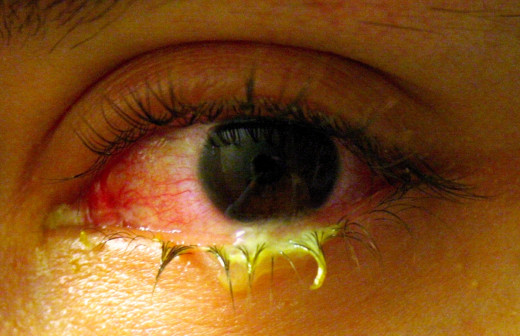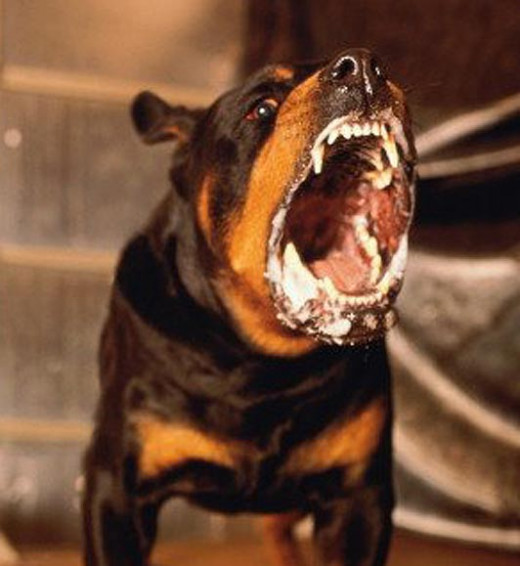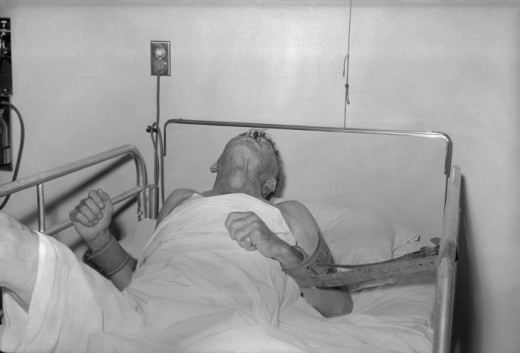Adenovirus Infection And Rabies (Hydrophobia, Lyssa): Their Clinical Manifestations, Diagnosis And Treatment
Conjunctivitis In Adenoviral Infection

Clinical Manifestation And Treatment Of Adenoviral Infection
Adenoviruses are a group of DNA viruses which cause a range of febrile disorders characterized by inflammation of the respiratory tract and conjunctiva and accompanied by submucous and regional lymphadenopathy. The name is derived from the fact that these viruses were first isolated from adenoid tissue removed surgically. The virus is 60 to 90 nm in size. Several serotypes are known. Adenoviruses are implicated in the production of acute respiratory disease, intestinal infections and mesenteric adenitis.
Clinical Features: Several clinical disorders are caused by these viruses.
- Acute febrile respiratory illness occurs more frequently in children. Paroxysms of cough may occur. X-ray shows patchy lobular pneumonia, encephalitis may develop as a complication.
- Acute pharyngo-conjunctival fever produces the classical triad of fever, pharyngitis and conjunctivitis. The disease subsides in 1- 2 weeks. Unilaterla or bilateral simple conjunctivitis may develop in some.
- Epidemic Kerato-conjunctivities may occur in outbreaks, affecting particularly shipyard workers and in harbour personnel. The onset is sudden with unilateral edema, conjunctivitis, superficial corneal opacities and lymphadenopathy. Later, the other eye is also involved. The course is for 3 to 4 weeks. The majority recover completely, though in a small proportion blindness may result from corneal lesions.
Treatment: It is symptomatic and supportive. Severe pneumonia in infants and epidemic kerato-conjunctivitis require special management.
Lymphocytic Choriomeningitis Is Usually Symptomless

Lymphocytic Choriomeningitis
The causative organisms, Arena Virus is an RNA virus seen in house mice and eliminated in their excreta. Man is infected from this source. In most cases, infection is symptomless, though meningitis may develop in a few. The onset is abrupt with high fever and meningism. Spontaneous recovery occurs in 5 to 7 days. The CSF is under tension and shows excess of lymphocytes, moderate increase in proteins, and normal values of sugar and chloride. Management is purely symptomatic.
Rabies From Affected Dogs' Bite

A General clinical Overview And pathology Of Rabies
Rabies is an acute viral disease, primarily of animals, clinically characterized by a rapidly progressive and fatal encephalitis, acquired by man through the bites or licks of rabid animals. Man to man transmission is extremely rare, though theoretically possible.
The etiological agent is an RNA virus belonging to the group of rhabdoviruses. When isolated first from animals, it was called “street virus”. This has a long incubation period and the virus multiples in the salivary glands and central nervous system. By repeated intracerebral passage in laboratory animals, it adapts to them. At this stage, it is called “fixed virus”. It has a shorter incubation period (4 to 6 days) and it loses its ability to multiply in the salivary glands.
All warm blooded animals are susceptible to rabies. Dogs are the most important in transmitting the disease to man. Transmission to man is effected by entry of the virus through the abrasions on the skin caused by bites, licks or scratches of dogs, contaminated by infected saliva. Aerosol transmission has also been documented. Less commonly, injury from cats, jackals, mongoose, wolves and other canines may transmit this infection. Rabies is prevalent in India. At least 15,000 deaths occur and over 700,000 antirabies vaccinations (ARV) are given annually. The high prevalence is attributable to the large number of stray dogs and ignorance of prophylactic methods among the population.
Pathology: The virus initially multiplies in skeletal muscles before invading the nervous system. From there, it passes on to the perineural tissue where heavy multiplication occurs in the spinal ganglia. The organisms pass to the spinal cord and brain and multiply further and produce cytopathic effects. The white and grey matter of the cerebrum show severe congestion. Perivascular and perineuronal infiltration with mononuclear cells occurs. Intracytoplasmic inclusion bodies (Negri bodies) are found and are demonstrable in 90% of cases. Negri bodies are seen in large numbers in the hippocampal gyrus, Purkinje cells of the cerebellum and the pyramidal cells. They are also seen in the basal ganglia, cranial nerve nuclei and spinal cord. While their presence is diagnostic of rabies, their absence does not exclude the diagnosis.
A Patient Suffering From Rabies

Infectious Diseases
Clinical Manifestations Of Rabies
It is generally thought that about 15% of subjects bitten by rabid animals develop clinical rabies. The incubation period may vary from 10 days to more than 2 months in most of the cases, but rarely it may extend up to 1 to 2 years. In bites on the face, the incubation period is the shortest, may be even less than 10 days. Bites from stray wild animals are more risky and dangerous. The disease manifests with prodromal symptoms like excitement, fever, malaise, anorexia, nausea and headache. Attention to the site of bite may be drawn by the tingling pain which develops before the appearance of spasm, psychotic behaviour with irrational and violent speels with intervening periods of calm may develop. Neurological involvement may lead to two forms of the disease- the spastic and the paralytic forms. The spastic form sets in at variable intervals (hours to a day or so) after the prodromal symptoms. Sensory stimuli which may be tactile, auditory or photic, provoke painful spasms. These are most marked and characteristic in the oropharynx. Swallowing liquid, and later on, a spray of water, its sight, or even thought of it, produce painful oropharyngeal spasms with respiratory distress. This symptom is called hydrophobia. Though, not pathognomonic, this is almost confirmatory of the diagnosis. Aerophobic spasms caused by a draught of air on the face or switching on the fan are also diagnostic. Sometimes, hysterical subjects adopt hydrophobic manifestations, but absence of aerophobia excludes this condition. The whole course extends to less than 5 days in almost all cases. The patient becomes comatose and death is due to respiratory paralysis resulting from bulbar involvement. It is highly unusual for human rabies to extend beyond five days after the onset of the first symptom.
© 2014 Funom Theophilus Makama









